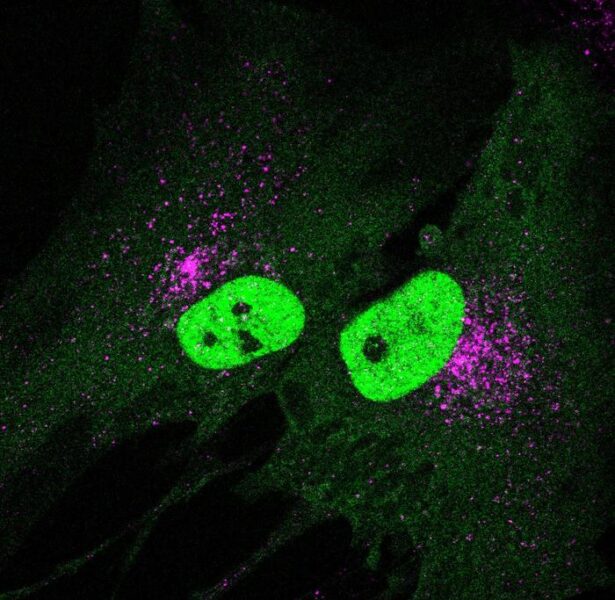Summary: Researchers at the University of Pittsburgh have discovered that the protein STING, known for its role in antiviral signaling, also helps cells clear stress and survive. This dual function has implications for aging and age-related diseases.
Estimated reading time: 6 minutes
In a surprising twist, researchers at the University of Pittsburgh have uncovered a new role for a protein previously known primarily for its involvement in inflammation and antiviral responses. The protein, called STING (Stimulator of Interferon Genes), appears to play a crucial part in helping cells manage stress and maintain their health as they age.
The study, published in the journal Molecular Cell, sheds new light on the complex functions of STING and its potential impact on age-related diseases and overall cellular health.
A Tale of Two Functions
STING has long been recognized for its role in detecting danger signals within cells, particularly when DNA appears where it shouldn’t – in the fluid-filled space of the cell known as the cytosol. This misplaced DNA can indicate various threats, from viral infections to cellular damage.
When STING detects these danger signals, it typically triggers an inflammatory response. While this inflammation is crucial for short-term threats, chronic activation of STING has been linked to various age-related conditions and the general aging process.
However, the new research reveals that STING’s role in cellular health is more nuanced than previously thought.
“It was quite surprising that STING has a protective function for cells to reduce stress and damage in addition to its well-known role in inflammation,” said senior author Jay Xiaojun Tan, Ph.D., assistant professor at the University of Pittsburgh and UPMC Aging Institute and Pitt’s Department of Cell Biology.
The Cellular Recycling System
The researchers discovered that when STING is activated, it sets off a chain of events that ultimately leads to the production of more lysosomes – cellular organelles often described as the cell’s recycling centers.
This process involves two transcription factors called TFEB and TFE3. When STING is activated, these factors move to the cell’s nucleus, where they turn on genes responsible for creating lysosomes.
“Lysosomes are organelles that are involved in autophagy, a cellular process that cleans up damaged material, almost like a housekeeping or recycling system,” explained Tan. “In response to STING activation, cells used TFEB and TFE3 to produce more lysosomes and increase autophagy.”
This newfound role of STING in promoting cellular cleanup is particularly intriguing because both lysosomes and autophagy are closely linked to longevity and healthspan – the length of time a person remains healthy.
Implications for Aging and Disease
The discovery of STING’s dual role complicates the current approach to developing therapies for age-related diseases. Some researchers have been exploring STING-blocking treatments, but Tan suggests this strategy may need reconsideration.
“Our findings suggest that balance of STING’s two functions is important for the health of cells and could have implications for future development of therapeutics for age-related diseases,” added first author Dr. Bo Lv, Ph.D., a postdoctoral researcher in Tan’s lab.
Instead of completely blocking STING, a more nuanced approach targeting specific components of the inflammation pathway downstream of STING might be more beneficial. This strategy could potentially preserve STING’s beneficial functions while mitigating its harmful effects.
An Ancient Cellular Mechanism
Interestingly, the components involved in STING’s newly discovered function – TFEB and TFE3 – are present across the animal kingdom. This suggests that STING’s role in promoting autophagy and lysosome production is more evolutionarily ancient than its inflammation-triggering function, which is only found in vertebrates.
Tan hypothesizes that this newly discovered function of STING may represent an ancient cellular quality control mechanism. Just as exercise challenges our bodies to grow stronger, mild cellular stress that activates STING might be important for maintaining cellular health.
“When we exercise regularly, we cause physical damage to our muscles, which triggers repair systems that over-repair and ultimately build muscle,” Tan explained. “I want to understand whether challenging our cells with mild stress in general could boost stress response systems, including lysosome activity, and help delay age-related diseases and improve healthspan.”
As research in this area continues, it may open new avenues for understanding how cells maintain their health over time and potentially lead to novel strategies for promoting healthy aging.
Quiz
- What is the newly discovered role of the STING protein?
- How does STING activation affect lysosomes in cells?
- Why might completely blocking STING be problematic for treating age-related diseases?
Answer Key:
- STING helps cells clear stress and survive, in addition to its known role in inflammation.
- STING activation leads to increased production of lysosomes and autophagy.
- Blocking STING entirely would also block its beneficial functions in cellular stress clearance and survival.
Further Reading:
- Overview of the STING pathway in innate immunity
- The role of autophagy in aging and age-related diseases
- Lysosomes as regulators of cell death
Glossary of Terms:
- STING: Stimulator of Interferon Genes, a protein involved in cellular signaling.
- Cytosol: The fluid component of a cell’s cytoplasm, excluding organelles.
- Lysosomes: Cellular organelles that break down and recycle various molecules.
- Autophagy: A cellular process for breaking down and recycling cellular components.
- Transcription factors: Proteins that help turn specific genes on or off.
- Healthspan: The period of life spent in good health, free from chronic diseases and disabilities.
Enjoy this story? Get our newsletter! https://scienceblog.substack.com/


